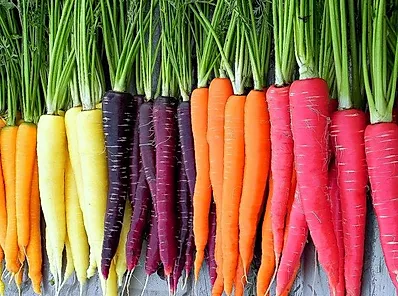Carrots
- jlrosner
- Jan 13
- 3 min read

The beta-carotene that is found in carrots was actually named for the carrot itself! Even though U.S. consumers are most familiar with carrots as root vegetables bright orange in color, an amazing variety of colors are found worldwide for this vegetable. These include purple, yellow, white and red carrots.
Carrots belong to the Umbelliferae family of plants, since their leafy greens form an umbrella-like cluster at the top of the root.
In today's commercial marketplace, China currently produces about one-third of all carrots bought and sold worldwide. Russia is the second largest carrot producer, with the U.S. following a close third.
Over 80% of all fresh market carrot production in the U.S. comes from California, with Michigan and Texas emerging as the next two largest fresh production states.
Carrots Nutrient Profile:
Carrots contain a fascinating combination of phytonutrients. They are an excellent source of vitamin A (in the form of carotenoids).
In addition, they are a very good source of biotin, vitamin K, dietary fiber, molybdenum, potassium, vitamin B6, and vitamin C.
They are a good source of manganese, niacin, vitamin B1, panthothenic acid, phosphorus, folate, copper, vitamin E, and vitamin B2.
Carrots Health Benefits:
Antioxidant Benefits
All varieties of carrots contain valuable amounts of antioxidant nutrients. Included here are traditional antioxidants like vitamin C, as well as phytonutrient antioxidants like beta-carotene.
There are beneficial antioxidants in all carrots and they differ based upon the different carrot’s color. For example, red and purple carrots contain anthocyanins, orange carrots have a large amount of carotenoids.
Cardiovascular Benefits:
There are numerous research studies documenting the cardiovascular benefits of carrots which are due to their antioxidant richness. Our cardiovascular system, in particular our arteries, needs constant protection from antioxidant damage.
In a recent study from the Netherlands, they determined that deeper shades of orange/yellow foods, in particular carrots, significantly reduced the risk of cardiovascular disease.
Vision Health:
Carrots have been shown to reduce the rate of glaucoma.
Anti-Cancer Benefits:
The anti-cancer benefits of carrots have been best researched in the area of colon cancer.
How to Select, Store, and Cook Fresh Carrots
Carrot roots should be firm, smooth, relatively straight and bright in color. The deeper the orange-color, the more beta-carotene present in the carrot.
Avoid carrots that are excessively cracked or forked as well as those that are limp or rubbery.
If the green tops are attached, they should be brightly colored, feathery and not wilted. Since the sugars are concentrated in the carrots' core, generally those with larger diameters will be sweeter.
To preserve their freshness, make sure to store carrots in the coolest part of the refrigerator in a plastic bag or wrapped in a paper towel, which will reduce the amount of condensation that is able to form. They should be able to keep fresh for about two weeks.
Carrots should also be stored away from apples, pears, potatoes and other fruits and vegetables that produce ethylene gas since it will cause them to become bitter.
If you purchase carrot roots with attached green tops, the tops should be cut off before storing in the refrigerator since they will cause the carrots to wilt prematurely as they pull moisture from the roots.
While heating can often damage some of the delicate phytonutrients in vegetables, the beta-carotene as found in carrots has been shown to be surprisingly heat-stable.
Individual Concerns When Consuming Carrots
Excessive consumption of carotene-rich foods may lead to a condition called carotoderma in which the palms or other skin develops a yellow or orange cast.
This yellowing of the skin is presumably related to carotenemia, excessive levels of carotene in the blood. The health impact of carotenemia is not well researched.
Excessive intake of carrots may over tax the body’s ability to convert these foods to vitamin A. The body slowly converts carotene to vitamin A, and extra carotene is stored, usually in the palms, soles or behind the ears.
If the cause of the carotenemia is eating excessively high amounts of foods like carrots, the condition will usually disappear after reducing consumption.
Recipe Suggestion:
This recipe for Moroccan Spiced Roasted Carrots was really easy to make and super delicious! Enjoy!







Comments